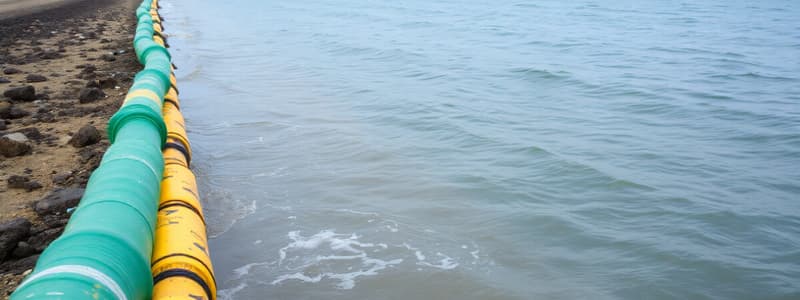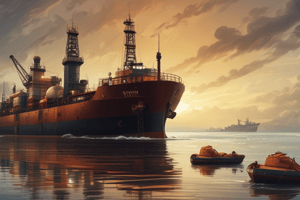Podcast
Questions and Answers
What is the main purpose of using containment and protection strategies in spill response?
What is the main purpose of using containment and protection strategies in spill response?
- To prevent any shoreline damage
- To expand the affected area of a spill
- To collect and recover spilled substances (correct)
- To increase the time taken for cleanup
Which type of boom is specifically mentioned to have a poor sealing capability on rocky surfaces?
Which type of boom is specifically mentioned to have a poor sealing capability on rocky surfaces?
- Shore sealing boom (correct)
- Guard boom
- Containment boom
- Inshore booming
What is one of the strategies employed to protect shorelines during a spill response?
What is one of the strategies employed to protect shorelines during a spill response?
- General monitoring
- Chemical dispersant application
- Boom deployment (correct)
- In-situ burning
When deploying boom in inshore booming strategies, what is a primary goal?
When deploying boom in inshore booming strategies, what is a primary goal?
What does the term 'deflect' refer to in spill containment strategies?
What does the term 'deflect' refer to in spill containment strategies?
What factor does the effectiveness of the deployment of boom depend on?
What factor does the effectiveness of the deployment of boom depend on?
Which strategy is NOT typically used to mitigate the effects of a spill?
Which strategy is NOT typically used to mitigate the effects of a spill?
What is one of the advantages of implementing boom deployment techniques?
What is one of the advantages of implementing boom deployment techniques?
What is the primary goal of coral re-mobilised oil during a shoreline clean-up?
What is the primary goal of coral re-mobilised oil during a shoreline clean-up?
Which of the following is NOT a tool mentioned for shoreline clean-up?
Which of the following is NOT a tool mentioned for shoreline clean-up?
What is one of the characteristics of large deflection booms in fast-flowing rivers?
What is one of the characteristics of large deflection booms in fast-flowing rivers?
Which offshore booming formation is described as providing good wave-following properties?
Which offshore booming formation is described as providing good wave-following properties?
What limitation might occur due to boom speed during oil recovery at sea?
What limitation might occur due to boom speed during oil recovery at sea?
What is a key advantage of using vessels of opportunity in offshore ancillaries?
What is a key advantage of using vessels of opportunity in offshore ancillaries?
What trend is noted in new equipment for shoreline clean-ups?
What trend is noted in new equipment for shoreline clean-ups?
Which of the following factors can limit the effectiveness of oil recovery operations?
Which of the following factors can limit the effectiveness of oil recovery operations?
Flashcards are hidden until you start studying
Study Notes
Containment & Protection Strategies
- Spill response strategies include containment and protection, dispersant application, monitor only, shoreline protection, shoreline clean-up and in-situ burning
- Each spill is unique and the chosen response strategies may vary
- Boom containment is a primary containment and protection strategy
- Boom containment protects shore/near shore sensitivities
- Boom containment deflects oil to collection areas
- Boom containment assists with shoreline clean-up
- Boom containment is used to corral and collect oil for recovery
Boom Types
- There are various boom types to choose from, each with its benefits and disadvantages
- Shore sealing boom is designed for a full tidal range
- Shore sealing boom should be set before the area is filled
- Shore sealing boom does not perform well on rocky surfaces.
Inshore Booming
- Booming is effective in diverting oil, protecting sensitive areas, assisting with shoreline clean-up and containing oil
- Boom angle, current velocity and boom location all impact the success of boom deployment
- Inshore booming requires ancillary equipment such as air blowers, water pumps and hoses, towing connectors, anchors, anchor chains, buoys and spares
Boom Deployment Techniques
- Booming deployment should occur in sections
- Booming deployment should be done in a seaward direction
- Deployment of boom in sections reduces the overall stress on the system
- Anchor boom to the shore using stakes or anchors
Booming Deployment Techniques
- Booming should be towed in a direction opposite the direction of the current
- River booming should be used with an angle of booms to account for fast moving currents
- Large deflection booms and small collection points are recommended for faster currents
- Multiple collection points may be necessary on rivers with fast currents
Offshore Booming
- Offshore booming is used for oil collection and recovery, in-situ burning, protection of deepwater inlets and fish farms
- Common offshore boom configurations are U, V and J shapes
- Single ship systems are another offshore booming option.
Offshore Booming Advantages & Disadvantages
- Offshore boom configurations have a large entrapment area
- Offshore boom configurations perform effectively in wave conditions
- Offshore boom configurations can be used with deflated sections
- Offshore boom configurations are limited in boom speed and only recover 10%-20% of oil at sea
- Offshore booming success is weather dependent
Offshore Booming Ancillaries
- Offshore booming utilizes vessels of opportunity with good communication and low speed manoeuvrability capabilities
Boom Limitations
- Current speed, splash over, drainage and manpower are factors that impact boom effectiveness
- Logistical support is a fundamental requirement for successful boom deployment
New Equipment Trends
- The trend in boom deployment is to move away from large, heavy systems.
Studying That Suits You
Use AI to generate personalized quizzes and flashcards to suit your learning preferences.




